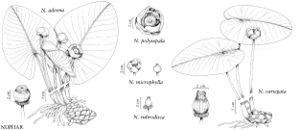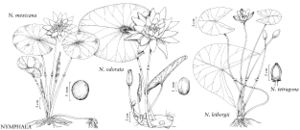Difference between revisions of "Nymphaeaceae"
imported>Volume Importer |
imported>Volume Importer |
||
| Line 62: | Line 62: | ||
|publication year= | |publication year= | ||
|special status= | |special status= | ||
| − | |source xml=https:// | + | |source xml=https://bitbucket.org/aafc-mbb/fna-data-curation/src/2e0870ddd59836b60bcf96646a41e87ea5a5943a/coarse_grained_fna_xml/V3/V3_379.xml |
}}<!-- | }}<!-- | ||
-->[[Category:Treatment]] | -->[[Category:Treatment]] | ||
Latest revision as of 21:48, 5 November 2020
Herbs, perennial, aquatic, rhizomatous; roots adventitious; air chambers conspicuous in vegetative portions of plant. Rhizomes branched or unbranched, erect or repent, tuberous-thickened, sometimes bearing stolons. Leaves arising directly from rhizome, alternate, floating, submersed, or emersed; stipules present or absent; petioles long. Leaf blade lanceolate to ovate or orbiculate, with basal sinus [peltate], margins entire to spinose-dentate. Inflorescences axillary or extra-axillary, flowers solitary. Flowers bisexual, protogynous [homogamous in some species of Nymphaea], diurnal or nocturnal, borne at or above water surface, occasionally submersed; peduncle long; involucre absent; perianth often persistent in fruit, hypogynous to perigynous [epigynous]; sepals usually (4-)5-12, distinct; petals numerous [rarely absent], often transitional to stamens; stamens numerous; filaments broad to slender; anthers dehiscing by longitudinal slits, with or without connective appendage; pistil 1, 3-35-carpellate and -locular; placentation laminar; ovules numerous per locule; stigma sessile, radiate on stigmatic disk. Fruits berrylike, indehiscent or irregularly dehiscent. Seeds several-numerous; aril present or absent; endosperm sparse; perisperm abundant; embryo minute; cotyledons 2, fleshy.
Distribution
Nearly worldwide.
Discussion
Genera 6 (including Barclaya), species ca. 50 (2 genera, 17 species in the flora).
Nymphaeaceae are insect-pollinated, often by beetles.
Formerly Nymphaeaceae often have been treated to include Cabombaceae and Nelumbonaceae, but these are now generally segregated.
Selected References
Illustrations
Key
| 1 | Perianth nearly globose at anthesis; stigmatic disk with margin entire to crenate or dentate, appendages absent; leaf venation essentially pinnate. | Nuphar |
| 1 | Perianth spreading at anthesis; stigmatic disk with prominent, distinct, upwardly incurved appendages around margin; leaf venation essentially palmate. | Nymphaea |

